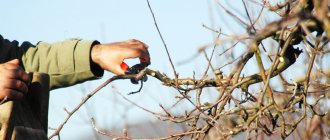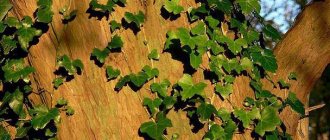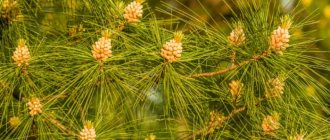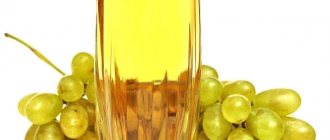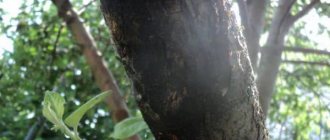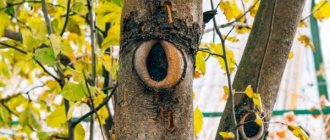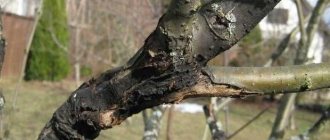What and how to prepare garden pitch?
There are many recipes for preparing classic brew. But the very first thing you should take care of is the dishes. Firstly, all ingredients are subjected to heat treatment in the form of melting, and secondly, it must be stored well packaged.
Cooking utensils:
- thick bottom pan
- water bath
- storage container. It should be either a glass jar or an iron ladle. Because if necessary, the cooker will need to be heated
- respiratory and hand protection
The Russian scientist Pashkevich proposed the following recipe:
- natural beeswax (best to buy at an apiary) – 550 gr.
- turpentine – 550 gr.
- rosin – 300 gr.
- any rendered animal fat – 100 gr.
Maintaining consistency, melt all ingredients until smooth. Pour the mixture in a thin stream into a container placed in cold water. After the garden varnish becomes a single mass, it can be rolled into balls and stored in plastic bags.
The following recipe is quite easy to prepare, sticks well to the trunk, does not melt or crumble in the cold:
- resin – 500 gr.
- medical alcohol – 80 ml.
- natural flaxseed oil – 1 1/2 tbsp. You can use any other one.
Melt the ingredients one by one in each other. The mass hardens quickly when it comes into contact with air. So it is convenient to keep this brew in a container that is subject to contact with the hot surfaces of the stove.
It is not at all difficult to prepare garden varnish on your own, but the gardener will always be sure that the trees have been treated with an absolutely safe and reliable product.
The third option is perfect for working at low temperatures:
- rosin – 300 gr.
- beeswax – 300 gr.
- natural rendered fat – 300 gr.
Also melt and mix everything. This version of garden varnish must be stored in oiled paper; baking paper is best suited. But it is best to wrap the treated areas on the trees with rags. Otherwise, the bees will be happy with such a treat.
What to cover the cuts on an apple tree with, other than garden varnish. How to cover a cut on an apple tree?
After the cleaned and disinfected cut on the apple tree dries, it must be covered with a special product.
This is done to seal damage to close the entrance to pests, bacteria and fungi. In addition, in the place of an unprotected cut, the branch may begin to dry out. This happens because:
- Sap flow is disrupted, nutrients do not reach the part of the branch that is located above the damage;
- Moisture evaporates through the wound.
An unprotected wound is prone to cracking, and sometimes the cracks are deep. A hollow may form in the place where the saw cut damaged the bark of the apple tree.
The following is used as putty:
- Garden var;
- A thick mash of clay and mullein;
- Oil paints on natural drying oil;
- Cement mortar – for particularly large damages;
- Water-based paints;
- Artificial bark (balm - varnish).
Garden var.
Garden varnish can be purchased at the store, or you can prepare it yourself. To prepare it, wax, rosin and fat are used.
The wax does not allow water to reach the wood and does not allow the putty to drain from the wound. The stickiness of rosin allows the varnish to firmly bond to the wood. Fat prevents the putty from cracking in any weather.
Any unsalted fat is suitable. You can replace it with vegetable oil or natural drying oil. Turpentine is suitable instead of wax.
- Take 1 part each of rosin and fat, and 2 parts of wax. Rosin, wax and fat are melted separately and then mixed. This solution is slowly poured into cold water. Take out after hardening;
- Also mix 20 parts of paraffin, 4 parts of rosin and 1 part of drying oil;
- Rosin and wax 2 parts each, vegetable oil - 1;
- Rosin 1.5 parts, oil - 2. Heat, mix and pour in 1 part of turpentine. It is important to do this away from the fire.
You can add ash to the garden pitch.
IMPORTANT! Before application, the garden pitch is slightly heated to soften it. Apply a very thin layer so that it appears as if a thin film has been applied to the cut.
If you cover the cuts on apple trees with a thick layer of garden varnish, the wood underneath will begin to rot after a while.
Clay chatter.
Clay mash: to prepare clay putty, take 2 parts clay, 1 part mullein, a little chopped straw or hay. Stir and dilute with water to the consistency of sour cream.
Cement mortar: 1 part cement, 3 parts fine sand mixed with water and a little drying oil added. Suitable for filling deep wounds and cracks.
Oil-based and water-based paints are washed off by rain after a while and will have to be renewed.
IMPORTANT! Apply any putty only to damaged wood. The edges of the bark must remain clean so that they can form a bark ridge that will heal the wound.
What is used instead of garden varnish?
If you don’t have freshly prepared garden varnish or suitable ingredients at hand, you can cope without it using scrap materials.
The simplest recommendation if emergency help for green pets is needed is to prepare the product according to the following recipe:
- Rotted cow manure – 10 parts
- slaked lime – 5 parts
- fine sand – 1 part
All ingredients should be thoroughly mixed and the wood treated. But this product is not resistant to moisture, so this is a temporary help.
Garden varnish can also be replaced with the following means:
- Cedar or pine resin is sold under the brand name “Zhivitsa”. Pine resin is cheaper. To use it, you need to melt it and mix it with wax and vegetable oil. By the way, you can collect resin with your own hands in the forest from coniferous trees.
- Medical turpentine. It is sold in pharmacies, and this type of turpentine is extracted from tree oleoresin. You must work carefully, the fumes are poisonous.
- Gum rosin. Only this one is suitable for working with living organisms.
- Natural beeswax. It is important that it is fresh.
If you have at least two of the above ingredients in your house, then you can safely mix them, season them a little with vegetable oil, and your homemade garden varnish recipe is ready!
There are nuances: garden varnish is good or bad. What to replace and when to use
Adding an article to a new collection
Garden varnish is a well-known remedy for healing wounds of fruit trees and shrubs. It is also called “garden band-aid.” How to use it, when to use it, and what you can treat plants with instead of garden varnish - read in our material.
Garden var has long established itself as a reliable assistant for summer residents in caring for trees and shrubs. But this mixture has both advantages and disadvantages. What nuances need to be taken into account when working with garden varnish, and is there a worthy alternative?
When and why is var used?
Garden pitch or its analogues in a gardener's household are an absolutely irreplaceable thing. Because any correction of trees opens access to moisture, bacteria, and abrasive dust particles inside the trunk. All this sometimes causes irreparable harm to fruit trees.
Hence, the immune system weakens, diseases develop, and the plant reduces its productivity. And if the damage to the bark was extensive, the tree may even die. So you should remember that any manipulation with pruning shears or garden shears must end with the use of varnish.
It is especially important to apply the varnish in early spring.
Cracks open in the bark, pieces of old bark may fall off, a thick layer of snow may break off branches over the winter, and the spring sun will burn the inner layers in places where the break occurs. Therefore, when good weather sets in, you should carefully examine your pets and treat weak spots with garden varnish.
You also need to put your garden into winter wisely. After all, not only sanitary treatment is important, but also reliable shelter. You need to choose the most suitable recipe and carefully cover all open areas. If the treated area or cut is exposed in winter, the procedure must be repeated. Among the recipes there is one that can be used during the cold season.
How to cover the cuts on a pear. We cover wounds and cuts in trees correctly
Cutting down the extra and unnecessary branches of a tree is only half the battle. Left cuts and untreated wounds are an open gate for dangerous infections and fungi. If they are not treated, you can lose trees that have been grown for many years.
You cannot cut down branches and cover up wounds in the same day. You need to give the wounds 5-10 days to dry.
Then the garden pitch will fall much better. In winter you have to wait up to ten days, and in spring, in dry weather, a couple of days are enough. Sections up to 2-3 cm in diameter are not covered. They overgrow quickly and infection does not occur. But it’s a good idea to disinfect them. Why dissolve 3-4 tbsp in a 2 liter bottle? spoons of iron sulfate.
For saw cuts larger than 3 cm, the following work is carried out:
- After trimming, the wound is cleaned with a sharp knife to remove burrs and irregularities.
- Using a brush, treat the saw cut with a solution of iron sulfate.
- Leave for several days to dry.
- Cover the wound with garden varnish or a similar product, being careful not to touch the bark along the edges of the cut.
How to treat a cut apple tree?
Wounds and cuts on trees must first be disinfected. How? There is a wide choice, here are just the most popular methods:
- 50 g of copper sulfate is diluted in 1 liter of very warm water;
- 50 g of iron sulfate are diluted in 1 liter of water;
- several granules of potassium permanganate are dissolved in 1 liter of water. The solution should turn out red;
- prepare a mixture of lime and copper sulfate. Why 30 g of lime is diluted in 0.5 liters of water and 30 g of copper sulfate is diluted in 0.5 liters of hot water. Pour the copper sulfate solution into the lime and stir all the time.
When treating wounds, be sure to wear rubber gloves.
A cut or a wound – what to cover it with?
After drying, a cleaned and disinfected cut or wound must be covered with a special agent. If this is not done, even if it does not become infected, the untreated wound is prone to cracking. Sometimes the cracks are very deep, which will worsen the health of the entire tree.
The most common remedy is garden varnish. It is better to choose a white color. It is not only practical, but also looks great after treating the wound.
RanNet putty is a completely different type. It seems that it consists of fine clay. May be washed away by rain. But it contains stimulants that accelerate wound healing. It makes sense to use it in spring and summer. During winter pruning, it is better to give preference to garden varnish.
For particularly large damage and hollows, using garden varnish is expensive and impractical. Cement mortar is prepared for them and wounds and hollows are closed with it. Also, large wounds can be sealed with a thick mash of clay, mullein and ash. It doesn’t last long, but it can always be renewed, and almost every gardener has the ingredients.
It is very good to cover saw cuts with water-based paints. You just need to be careful so that when moving in the crown, you don’t get smeared in it. In this regard, garden var is more advantageous. Only in cold weather is emulsion preferable, since the varnish hardens and does not want to lay down in a thin layer.
Recently, you can buy artificial bark (balm-varnish) in seed stores. Reviews about it are good. But it costs much more than garden varnish.
Substitutes
Sometimes it’s not easy to cook or buy ready-made varnish, and the condition of the tree does not inspire concern. In this case, they make do with improvised means, but there is no need to wrap the cut with film or cover it with plasticine. The film creates a greenhouse effect, which favors the development of phytopathogens, and plasticine in the open air quickly dries out and cracks or, in the heat, softens and flows.
The traditional replacement for garden pitch is a clay-dung mash: add 0.5 kg of dry ground mullein to 1 kg of wet fatty clay, add finely chopped straw, as in adobe, and 1-2 tsp. copper sulfate. But, firstly, despite the presence of a biocide, this composition is still unfavorable in terms of phytopathology. Secondly, foliar nitrogen fertilization of grafted varietal trees will at least give increased growth of new shoots and green mass to the detriment of the harvest and can even provoke the release of tops from the rootstock.
It is best to replace garden varnish with thickly grated oil paint mixed with natural drying oil; alkyd, glyphthalic, etc. “smelly” ready-to-use paints based on organic solvents are absolutely unsuitable! Garden paint does not have a therapeutic or prophylactic effect, but it stays on the cut for years until the wound heals completely. For information on treating tree cuts with paint instead of varnish, see the video:
Video: using paint instead of garden varnish
Acrylic waterproofing mastic
Currently, there is a material on sale that also replaces general-purpose varnish, but is absolutely harmless, in no way biologically active and chemically neutral, stable in the open air, odorless and easily washed off hands and clothes until it begins to set. This is acrylic mastic (liquid waterproofing); found on sale in hardware stores under the names Hydropan (see figure on the right), Hydrostop, etc. For gardening purposes, mastics for cars and roofs are suitable, i.e. for external use; “internal” mastics, for example. for floors, not UV resistant enough. By the way, garden varnish in aerosol packaging, which is now heavily advertised and sold at high prices, is the same polymer waterproofing.
What is it used for?
A viscous mixture that looks like wax is used to treat trees. It clogs the bark, preventing microbes, parasites, fungi and insects from penetrating the damage. Thanks to the seal made from garden varnish, the plant does not lose juice. This way, treatment can prevent serious diseases that could cause the garden to die. Most often, garden var is used if:
- incorrect pruning was carried out;
- the vaccination was done incorrectly;
- a branch broke;
- rodents have damaged the bark or roots.
You will need:
7 useful devices for a modern summer resident There is an opinion that working in a summer house is a rather tedious task that takes a lot of effort and time...
After application, the mixture does not need to be further fixed. It doesn't get your hands and clothes dirty. The composition is easy to use: even a novice gardener can handle it. The product is sold in different packages. If you need a little of it, you can buy a tube. It makes it easy to calculate the required volume. For larger gardens, there are buckets in stores. When buying the composition with a reserve, you need to organize a warm place for storage, otherwise the entire package will freeze with the onset of winter.
Garden varnish - to use or not?
There has always been controversy regarding the use of putties. Some gardeners argue that any cuts on the tree should be covered, this will protect the plant from various infections - pathogenic fungi and pests.
The second category of gardeners argues that under no circumstances should wounds be covered, nature itself took care of this, plants have a protective function. Using putties, you can slow down the healing process of wounds or stop it altogether, which creates an ideal environment for the development of fungi and pests under the lubricants.
Garden var
under the influence of temperatures it either freezes or spreads - it turns out that an ideal environment from pests is formed under it. If we compare it with Europe, they don’t use putties there, but apply special paint to the cut or don’t process it at all.
If you prune trees on time, before the growing season, then the wounds do not need to be covered up.
Video - Review of garden varieties
Store-bought garden varnish or how we are being deceived
In the USSR, stores sold classic garden varnish, the basis of which was tree resin. But, since the 90s of the last century, entrepreneurs realized that they could make good money with this product if they lowered the cost and began to work miracles. Let's look at the composition of popular “garden brews” that can be found in online stores and on the shelves of shopping centers.
Is RanNet a garden variety?
It is positioned as a garden variety, but it is not. Online stores are silent about the full composition; they only talk about copper sulfate and dietary supplements.
I managed to find out that the basis of this product is 3M latacryl. This is a thermoplastic adhesive, which, moreover, is manufactured according to technical specifications, and not according to GOST. Widely used in construction and repair for gluing various materials.
According to reviews from experienced gardeners, for example in this article, RanNet is quickly washed off with water. This means that it is able to penetrate between the cells of the cambium and slow down the healing of wounds on the tree.
Robin Green is another representative
In online stores you can find such delights as Robin Green garden varnish. It is produced in the form of sausages and, according to the manufacturer, has bactericidal and wound-healing properties.
Let's study the composition of this miracle:
- petrolatum;
- vegetable wax;
- other dietary supplements.
The last point delivers. The consumer must wonder what it is, and the manufacturer must proudly remain silent about it. Vegetable wax also touches. It’s the same as vegetable oil, without specification, sunflower or soybean oil. It could be anything from carnauba palm wax to rice wax.
But most of all, the first substance (the main one) caused a bitter smile - petrolatum: a by-product of petroleum oil refining, consisting of paraffin and ceresin. This is a toxic substance that causes comedones in people.
Petrolatum is the basis of 90% of store-bought “garden preparations” due to its low cost and viscosity. But, if it is used in gardening, irreparable damage will be caused to the tree. In addition, it interferes with the normal fusion of tissues and slows down their healing.
Other wonders of commercial thought
I won’t torture you too much and go deep into the features of store-bought products. I will list those that, in my opinion, are not varieties and can harm your apple or cherry tree.
- "August". The basis of the composition is the notorious petrolatum.
- "Green Belt". Composition identical to Robin Green.
- "Gardener". There is tree resin, but the base is again petrolatum.
- "Fasco". The composition is the same as that of “Gardener”. They disguise it under the phrase “combination of paraffin-like compounds.”
- "Inta Vir" - again petrolatum.
Honestly, I was shocked when I was looking for a normal garden varnish and couldn’t find it. No benefit, total harm. So, we will prepare this remedy with our own hands. Not for the purpose of saving (it will cost more), but for your own safety.
Garden var application. How to make your own putty
Garden var
- a well-known remedy among gardeners, with which you can cover up wounds and damage to trees and shrubs, and also use it after pruning.
Let's figure out where and how to use garden varnish
in the garden, what it consists of, how to prepare garden varnish with your own hands or what to replace it with, proper processing of saw cuts on fruit trees.
In spring, garden varnish is used after pruning to protect against fungi, moisture and temperature changes.
In autumn, garden varnish is used to protect against frost and rain.
Recommendations, tips, where to find components
First I’ll give you the theory, then we’ll move on to the recipes. Perhaps the names of the components are unknown to you, so I’ll tell you what it is and how it can be used. I will also provide links to resources where you can buy the ingredients.
Wood resin (cedar, pine)
On the Internet you can find it under the name “resin”. The cost per 1 kg ranges from 400 to 1700 rubles. It seems to me that it is better to buy pine resin; it is 1.5-2 times cheaper than cedar resin. You can find it on the Agroserver website, for example, from this seller. I called him, they pack the resin in 1 kg pieces, but they can make 0.5 kg pieces. Price 1000 RUR/kg. Telephone .
It melts in a water bath, but hardens as it cools. To avoid this, beeswax or vegetable oils are added to the resin.
On a note. If you live near coniferous forests, then you can collect resin yourself. It's easier and free.
Turpentine is a common ingredient
Turpentine is turpentine. It's better to buy at a pharmacy. For medical purposes, turpentine is obtained from tree sap; this product is less toxic than sulfate turpentine.
You need to work with it carefully. May cause allergic reactions upon contact with skin. The vapors are toxic, cause irritation to the mucous membranes of the eyes, and if inhaled, affect the lungs and nervous system. If you use a garden varnish recipe that contains this component, prepare it outside, do not lean over the container and protect your respiratory system with a cotton-gauze bandage.
Rosin - not for soldering
An ingredient with an insidious name that can be found in old, pre-revolutionary books on gardening. Why did I call him that? Yes, because this is resin, but processed. At least that's what they once called it.
To prepare garden varnish, use gum rosin. But tallow and extraction are not suitable. However, even gum rosin can be found in a store selling products for welding and soldering.
Rosin has no healing properties. But it melts at temperatures from 40 to 75 0C (depending on the source raw material), has good fluidity, and penetrates into the smallest cracks. Classic garden varnish is applied in melted form and rosin acts as a binder, preventing the putty from falling off.
Beeswax
In garden varnish recipes, it is used to soften oleoresin. It is advisable to use fresh wax that is white-yellow in color and has a characteristic odor.
It is crushed and mixed with other ingredients or melted separately. For these purposes, use a water bath. Take a saucepan and fill it with water. Place a container with a smaller diameter into it and pour the wax into it. This way it will heat up and not lose its properties.
Garden pitch and lime are the main protectors of fruit tree trunks
Just three simple autumn procedures - cleaning tree trunks, disinfecting them and whitewashing - can extend the life of our gardens for years.
Fruit tree defenders
How and why to carry them out is explained in the articles Whitewashing trees: when, how and whether it is necessary at all and How to properly whitewash trees in the garden. This publication is for those who do not really trust purchased tools for processing trunks and prefer to make them themselves. The proven recipes we have collected for garden varnish and whitewash can be a good help in this.
